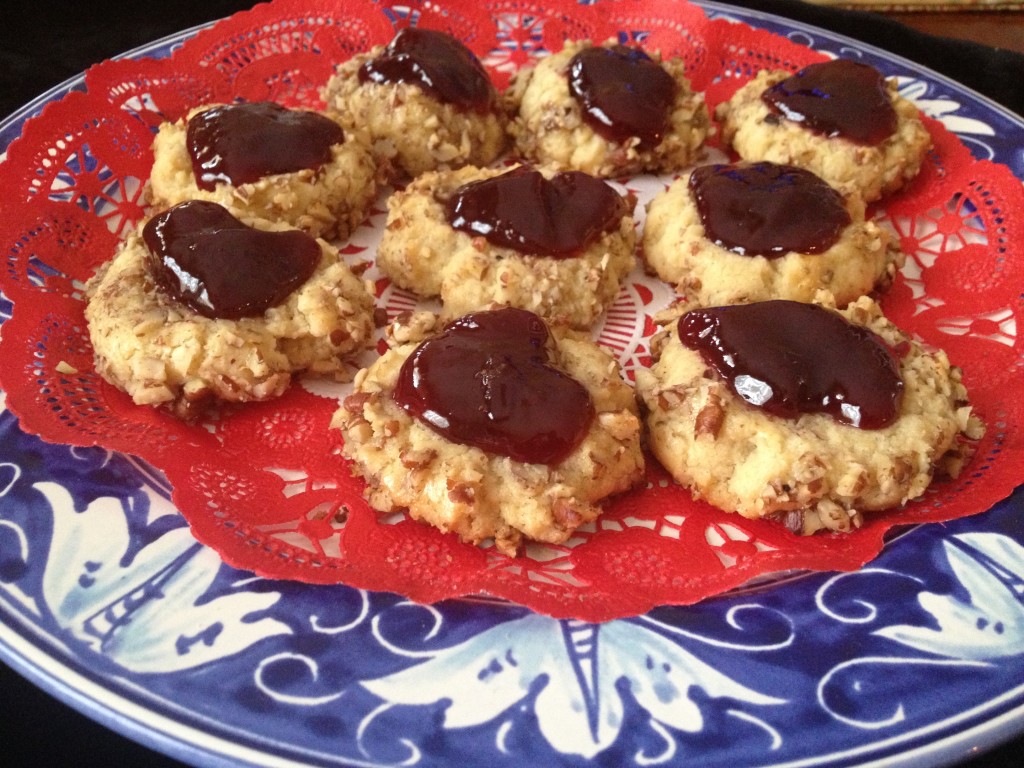 As part of our celebration of “all things Russia” for Valentine’s Day, be sure to read our post in Rose’s Ridge: “From Russia With Love.”
As part of our celebration of “all things Russia” for Valentine’s Day, be sure to read our post in Rose’s Ridge: “From Russia With Love.”
Enjoy a Russian meal with recipes below for Cabbage Soup, Chicken Kiev, and Russian Tea Cookies.
“Shchi” (Cabbage Soup)
“In Russia, cabbage soup…is made from cabbage, carrots, meat, onions, celery, and garlic, with a sour flavoring from apples, sour cream, or sauerkraut juice. A favorite for at least a thousand years, it can be found in Russian poems and prose, on the table of both rich and poor, and in the fond memory of every exile.” –Taken from Life is Meals by James and Kay Salter
Hearty Cabbage Soup for a Cold Winter Day
Ingredients:
4 cups cabbage, finely chopped
1 cup white onion, finely chopped
1 tbsp. garlic, minced
2 carrots diced
1 28 ounce can crushed tomato
Olive Oil
8 tbsp. butter
8 tbsp. flour
1 1/2 quarts chicken broth
2 cups potato, raw, peeled and finely diced
5 slices bacon, raw, finely chopped
Salt and pepper to taste
Instructions:
- In soup pot, sauté chopped bacon, onion and garlic in a bit of butter.
- Add cabbage, chicken broth, crushed tomato and diced potato and carrots and simmer for an hour, stirring occasionally.
- Meanwhile, mix in small bowl 4 tablespoons of butter with 4 tablespoons flour into a paste. Pour a ladle of hot broth into the paste mixture and whisk until smooth, pouring the paste/broth mixture back into soup pot, stirring until thoroughly combined.
- Season with salt and pepper and add the sautéed bacon.
- Serve very hot with a dollop of sour cream.
Chicken Kiev
A “hearty dish of chicken filled with butter wrapped in bread crumbs, and deep fried” one would think by its name that it originated in the capital city of Ukraine, Kiev. However, according to Amy Guttman’s research, it originated in France and was brought back to Russia after Russian royalty sent chefs to Paris in the 1840’s to learn “from the best.”
In Paris the dish was made with veal but when the Russian chefs returned they used chicken as it was a meat that was more highly esteemed. The dish is traditionally deep fried and can be stuffed with a cheese, such as mozzarella. After WWII it became a “popular dish at white tablecloth restaurants such as the Russian Tea Room in New York City.” Over time the dish fell out of favor but, according to Guttman’s article, seems to be making a comeback as a hearty winter comfort dish.
Ingredients:
6 thin slices of boneless chicken breast
1 stick of butter
2 eggs
1 clove garlic
Approx. 1 tbsp. lemon juice
Approx 1 tsp. italian seasoning
Salt and pepper
1 cup or more of flour
2 -3 cups of bread crumbs ( we use fresh)
Instructions:
- Lay chicken pieces on wax paper and salt and pepper.
- Prepare “compound” butter: into softened stick of butter mix the lemon juice, Italian seasoning and finely minced garlic (can use garlic powder). Wrap in wax paper and mold into a square and refrigerate for 20 minutes.
- Place the following in separate bowls: flour, whisked eggs, bread crumbs.
- When ready to fry, remove butter from fridge and cut into 6 pieces. Wrap each chicken piece around a slice of the butter.
- Dip chicken piece carefully without unwrapping (this can be a little messy) first in flour then egg wash and then the bread crumbs. Place on dish.
- Fry chicken in large skillet with a little olive oil and several tablespoons of butter (add more butter as needed while you go). Fry each side for several minutes and place in ovenproof dish.
- Finish chicken by baking in 400 degree oven for approx. 20-25 min.
Serve with potato pancakes, peas, green beans or roasted carrots.
Russian Tea Cookies (pictured above)
Ingredients:
1/2 cup brown sugar
1 cup butter (2 sticks) room temp.
2-3 egg yolks
2 cups flour
Egg whites
1 – 1 ½ cups chopped pecans
Raspberry preserves (Trappist or Bonne Maman)
Instructions:
Cream together sugar, butter and egg yolks. Stir flour into mixture. Form balls and dip into slightly beaten egg whites. Roll balls in chopped nuts. Put on lightly greased cookie sheet and make a thumbprint on each ball. Bake at 350 degrees for 6-8 minutes. Remove from oven and reset thumbprint. Bake 6-8 minutes longer. Remove from oven and fill print with raspberry preserves.
*Nostrovia means “to good health” or “cheers” and is a miss-pronunciation of the Russian word “Na Zdorovie.”

It’s not “Na zdorovje”, it’s “ZA zdorovje”, which means “to health” in reference to cheers. “Na zdorovje” means “you are welcome!” When somebody thanks you.
Thank you for the correction!
Found your post on Google, the headline caught my eye and it was a great read.